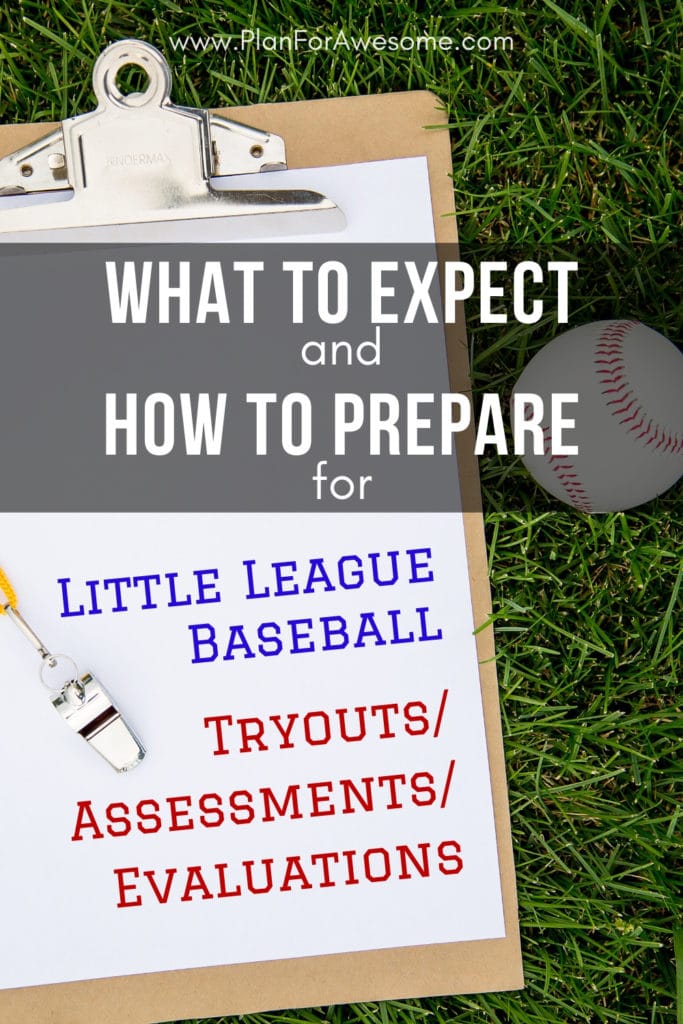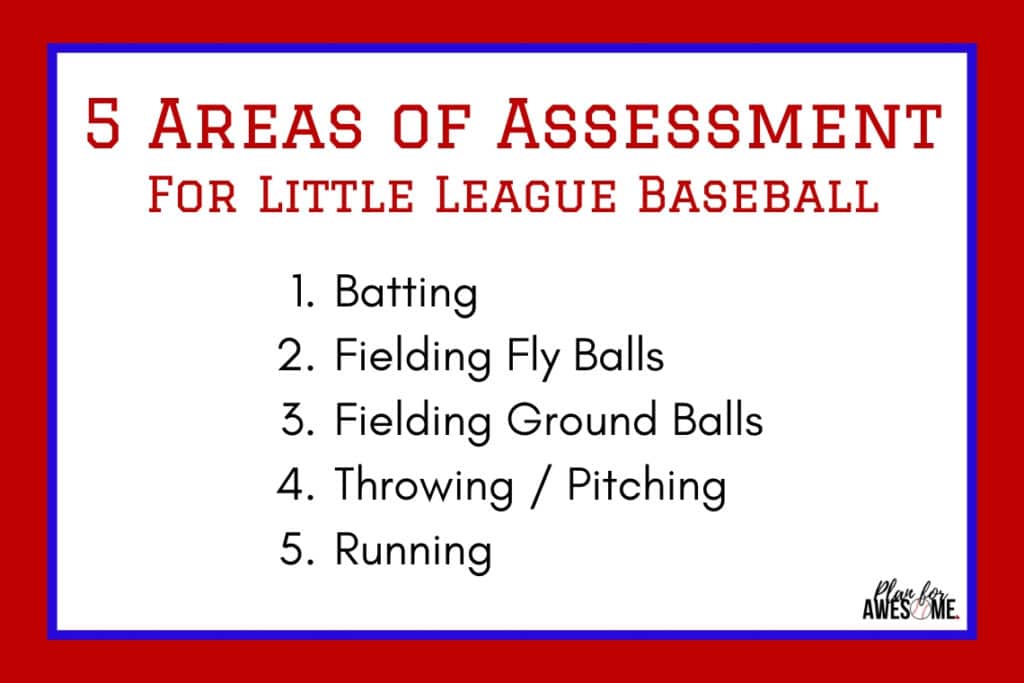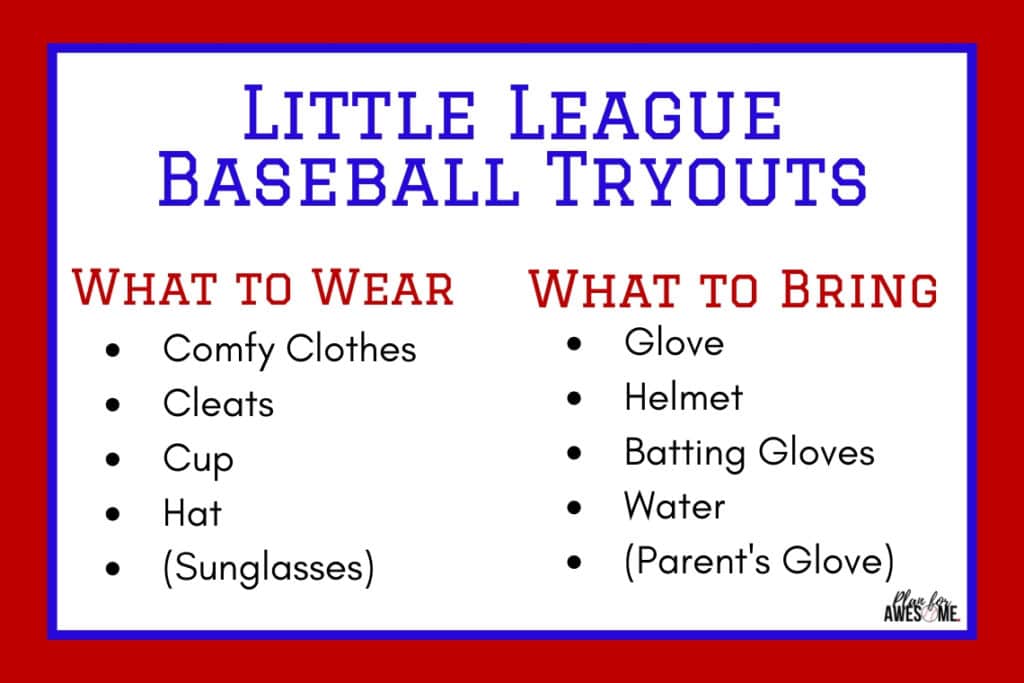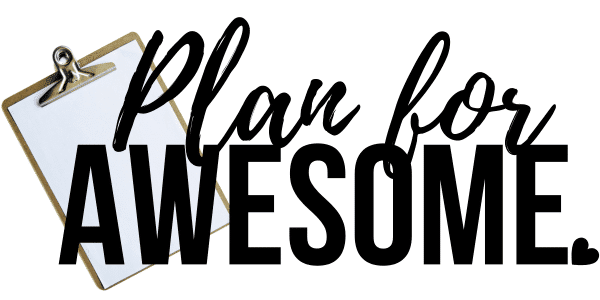Preparing for Little League Baseball Assessments/Evaluations
So…you’ve signed your kid up for Little League: now what?! ASSESSMENTS! EVALUATIONS! TRYOUTS! This post will walk you through the tryouts (also referred to as evaluations or assessments) process, including what you need to wear, what you need to bring, and what you should expect on baseball assessments day!

Little League Tryouts/Assessments/Evaluations
When are Little League Tryouts?

Most Little Leagues open registration in November or December, and close when tryouts/assessments start in January.
The league should post some sort of notice of assessments with a short list of things to wear/bring, so keep an eye on your email or their Facebook page so you don’t miss it.
Why the Heck Does a 7-Year-Old Need to “Try Out?”
Don’t be intimidated by the word tryouts. Everyone makes the team in Little League. Tryouts (or assessments) are simply for the league to be able to spread the level of talent around.
Most leagues don’t have assessments for Tee Ball, but all other levels (about age 7 and up) do.
What Exactly is Assessed in Tryouts?
Players should be evaluated in each of the following 5 areas: (source: LittleLeague.org)
- Batting
- Fielding Ground Balls
- Fielding Fly Balls
- Throwing / Pitching
- Running

How Can You Prepare Your Child for Baseball Assessments?
1 – PRACTICE WITH THEM
It is a good idea to knock the rust off the old baseball glove a little sooner than in the car on the way to evaluations. We start talking about baseball around Christmas time (mainly because we like to gift at least one new piece of sporting equipment to each kid for Christmas, and baseball is the next sport in line after December 25th). It may sound crazy, but while the actual baseball games don’t start til March, registration ends on or before Assessments, which are usually in early January.
2 – ENCOURAGE THEM
- Assure them that they will make it on a team, regardless of their performance at evaluations
- Remind them that all the other kids are just as nervous as they are
- Encourage them to HAVE FUN!!!!
3 – SET THEIR EXPECTATIONS
- Although tryouts typically last a couple hours, each child gets very little time to show what he or she can do
- For example, each child will likely only field 3-5 fly balls and grounders
- There will be a LOT of waiting and standing in lines
- Encourage your child to always be focused and paying attention to where their group is headed so they don’t get left behind
What to Wear to Tryouts
- Comfy Clothes – make sure your child is wearing some sort of comfortable clothes (baseball pants are okay, but not required)
- Cleats
- Cup – only for boys, of course
- Hat – to block the sun
- Sunglasses – only if your child is used to wearing them and playing baseball while wearing them

What to Take to Tryouts
- Glove
- Helmet – if you have one (they have some community helmets available for those who don’t have their own, but…for my brief one-word explanation of why my kids will always have their own helmet, see this post!)
- Batting Gloves – only if you have them
- Water
- Parents’ Glove (see “What is the Tryouts Process?” below)
Do Parents Stay and Watch Tryouts?
This depends on the process with your particular league. From what I’ve seen, most leagues are okay either way.
I have been to some incredibly organized tryouts where I didn’t say a word to my kid the entire time, and then I’ve also been to some not-so-organized tryouts, where I was really glad I was there to help guide my kid to the next area he was expected to be at.
I have also seen indoor tryouts where the parents couldn’t see anything anyway, so I decided to run to Target while the kids were in there. So it all depends. If you aren’t sure how it’s going to go down, I would plan on staying there just to be safe. I think generally speaking, most parents stay.
If you are going to leave and come back, make sure you come back really early. You don’t want your kid waiting for an hour for you if they finish early.
What is the Evaluation Process?
- Check-In
- You will most likely stand in a really long line for a really long time to check your child in
- Your child will receive a number to attach to the front and/or back of his/her shirt
- Wait
- Remember how you waited in that really long line? You will need to wait for everyone else to get through that really long line too, so come prepared to wait a lot
- Depending on the set-up of the event, kids can start warming up and playing catch with each other while they wait
- You might want to consider bringing a glove for yourself to be able to play catch with your child while you wait
- Gather in Your Assigned Group
- Most tryouts will have a few different groups of kids, and each group will rotate through the different stations (batting, fielding, throwing, and running)
- Rotate Through the Evaluation Stations
- This is where the kids need to pay attention to their group and where they are rotating
- Depending on how tryouts are set up, parents may want to keep an eye on their kids to ensure they are where they are supposed to be
- Go Home
- After your child is finished at the last station, they are usually free to leave
- Don’t expect a formal meeting at the end or a big kumbayah moment or anything – it’s pretty anticlimactic
Being Assigned a Little League Team

Teams are usually formed within a couple weeks of tryouts. This process is subject to the league having enough coaches who have volunteered to COACH that season. They can’t really form teams without coaches to coach those teams, so that is usually the biggest reason for a delay in forming teams.
It is generally up to the coach to contact the players once he/she has a final roster in hand. The coach will let you know when and where practices will be, and will quite possibly have a team meeting to start out the season and get you all the information you need.
For help getting organized as a coach, see COACH’S CORNER.
One final note: The game schedule typically isn’t released until VERY CLOSE to opening day. As frustrating as this is, it is what it is. The leagues are working with a fairly small window of time between the close of registration, then assessments, and then coming up with a game schedule for the entire league. So be patient.
Once you’ve made it through the assessments process, it’s time to get ready for the FIRST DAY OF PRACTICE! Click here to see what you can do to make sure your child (AND YOU) are prepared and ready to roll on the first day of practice!
